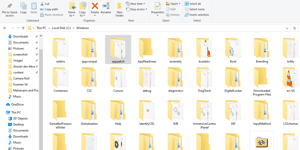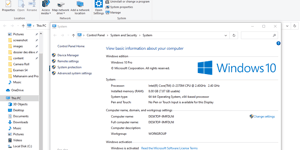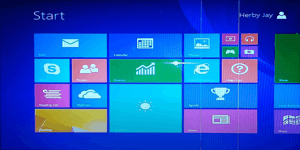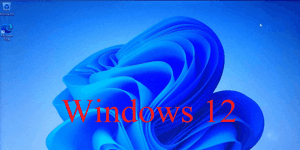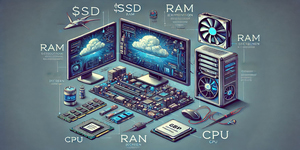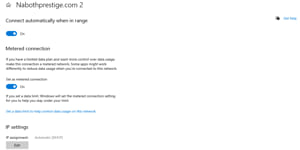Windows is an operating system (OS), also known as the Windows operating system, developed by Microsoft Corporation. An operating system is software that manages the hardware resources of a computer and allows users to run programs and interact with their computer.
Windows is one of the most commonly used operating systems in the world, and there are many different versions of Windows, including Windows 10 and Windows 11 , which are the latest versions. Each version has brought improvements and new or enhanced features.
Here’s a brief overview of the Windows operating system versions you mentioned, including release dates, system requirements, and other relevant details:
Windows 1.0
Windows 1.0 (Release Date: November 20, 1985)
System Requirements: Windows 1.0 required an Intel 8086/8088 processor, 256KB of RAM, and two double-sided floppy disk drives. It was primarily a graphical user interface (GUI) shell that ran on top of MS-DOS.
Key Features: Windows 1.0 introduced the concept of a graphical user interface to the MS-DOS platform. It allowed users to run multiple applications in resizable windows and provided basic tools like Paint, Notepad, and Calculator.
Windows 2.0
Windows 2.0 (Release Date: December 9, 1987)
System Requirements: Windows 2.0 had slightly higher system requirements than its predecessor, including a 286 processor, 512KB of RAM, and a hard drive. It still ran on top of MS-DOS.
Key Features: Windows 2.0 improved upon the original by introducing overlapping windows and more advanced features for its time. It also brought better support for graphics and expanded application compatibility.
Windows 3.0
Windows 3.0 (Release Date: May 22, 1990)
System Requirements: Windows 3.0 required an Intel 80286 processor, 1MB of RAM, and a hard drive. It marked a significant improvement in terms of performance and capabilities.
Key Features: Windows 3.0 was a major success for Microsoft. It introduced better graphics, improved multitasking capabilities, and enhanced support for a wider range of applications. The Program Manager and File Manager were notable additions.
Windows 3.1
Windows 3.1 (Release Date: April 6, 1992):
System Requirements:
- CPU: 80386 processor or better
- RAM: 4 MB (8 MB recommended)
- Hard Drive: 20-30 MB of free space
- Graphics: VGA graphics adapter
Key Features:
- Improved stability and performance over Windows 3.0.
- Introduced Windows for Workgroups, adding networking capabilities.
- Included various accessories and multimedia features.
- Enhanced support for TrueType fonts.
- It was a significant update to Windows 3.0 and included bug fixes and refinements to the user interface.
Windows 95
Windows 95 (Release Date: August 24, 1995):
System Requirements:
- CPU: 386DX processor or better
- RAM: 4 MB (8 MB recommended)
- Hard Drive: 35-55 MB of free space
- Graphics: VGA graphics adapter
Key Features:
- Introduced the Start Menu and Taskbar, which became staples in Windows.
- Provided significant improvements in the GUI and user experience.
- Included native support for 32-bit applications.
- Introduced plug-and-play hardware support.
- Supported long file names and the FAT32 file system.
- Windows 95 was a major step forward in terms of usability and modernizing the Windows interface.
Windows 98
Windows 98 (Release Date: June 25, 1998):
System Requirements:
- CPU: 486DX processor or better
- RAM: 16 MB (24 MB recommended)
- Hard Drive: 200-400 MB of free space
- Graphics: SVGA graphics adapter
Key Features:
- Enhanced support for hardware devices and USB devices.
- Included Internet Explorer as an integral part of the OS.
- Improved system stability and support for multimedia.
- Introduced the FAT32 file system as the default.
- Added support for DVD drives and playback.
Windows Me
Windows Me (Windows Millennium Edition) (Release Date: September 14, 2000):
System Requirements:
- CPU: 150 MHz Pentium processor or better
- RAM: 32 MB (64 MB recommended)
- Hard Drive: 320-475 MB of free space
- Graphics: SVGA graphics adapter
Key Features:
- Focused on improved multimedia and home networking features.
- Introduced System Restore for easier system recovery.
- Included Windows Media Player 7 and Windows Movie Maker.
- Enhanced support for digital cameras and USB devices.
- Generally considered less stable than Windows 98 and not as well-received.
Windows 2000
Windows 2000 (Release Date: February 17, 2000):
System Requirements:
- CPU: Pentium II processor (233 MHz or faster)
- RAM: 64 MB (128 MB recommended)
- Hard Drive: 2 GB of free space
- Graphics: SVGA graphics adapter
Key Features:
- Available in two editions: Windows 2000 Professional for business desktops and Windows 2000 Server for servers.
- Enhanced stability and security compared to Windows 9x.
- Introduced Active Directory for network management.
- Supported Plug and Play hardware and included improved support for NTFS (New Technology File System).
- Marked a significant step towards a more robust and reliable Windows operating system.
Windows XP
Windows XP (Release Date: October 25, 2001):
System Requirements:
- CPU: Pentium III processor (300 MHz or faster)
- RAM: 128 MB (256 MB recommended)
- Hard Drive: 1.5 GB of free space
- Graphics: SVGA graphics adapter
Key Features:
- Available in multiple editions, including Windows XP Home and Windows XP Professional.
- Introduced a more user-friendly interface and improved multimedia features.
- Enhanced stability and performance.
- Introduced Windows Product Activation for software authentication.
- Supported fast user switching and remote desktop features.
- Became one of Microsoft’s most popular and enduring operating systems.
Windows Vista
Windows Vista (Release Date: January 30, 2007):
System Requirements:
- CPU: 1 GHz processor (32-bit or 64-bit)
- RAM: 512 MB (1 GB recommended)
- Hard Drive: 15 GB of free space (20 GB recommended)
- Graphics: DirectX 9-capable graphics adapter with a WDDM driver
Key Features:
- Introduced a redesigned interface called “Aero” with new visual effects.
- Enhanced security features like User Account Control (UAC).
- Included Windows Search for improved file and document search.
- Introduced Windows Sidebar with widgets (gadgets).
- Supported 64-bit computing and advanced multimedia capabilities.
- Had multiple editions, including Windows Vista Home, Business, and Ultimate.
Windows 7
Windows 7 (Release Date: October 22, 2009):
System Requirements:
- CPU: 1 GHz processor (32-bit or 64-bit)
- RAM: 1 GB (32-bit) or 2 GB (64-bit)
- Hard Drive: 16 GB of free space (20 GB for 64-bit)
- Graphics: DirectX 9-compatible graphics device with WDDM 1.0 driver
Key Features:
- Improved stability and performance over Windows Vista.
- Introduced the taskbar with enhanced thumbnail previews and Aero Peek.
- Included the HomeGroup feature for easy file and printer sharing on home networks.
- Introduced a revamped Start menu with a search bar and customizable shortcuts.
- Supported XP Mode for running older Windows XP applications.
- Offered various editions, including Home Premium, Professional, and Ultimate.
Windows 8
Windows 8 (Release Date: October 26, 2012):
System Requirements:
- CPU: 1 GHz processor with PAE, NX, and SSE2 support (32-bit or 64-bit)
- RAM: 1 GB (32-bit) or 2 GB (64-bit)
- Hard Drive: 16 GB of free space (20 GB for 64-bit)
- Graphics: DirectX 9-compatible graphics device with WDDM 1.0 driver
Key Features:
- Introduced the “Metro” user interface, characterized by live tiles and a Start screen.
- Focused on touch-friendly features and compatibility with both traditional PCs and tablet devices.
- Included Windows Store for downloading and installing modern apps.
- Improved performance and startup times compared to Windows 7.
- Enhanced security features like Secure Boot and Windows Defender.
- Removed the traditional Start menu, which received mixed reactions from users.
Windows 8.1
Windows 8.1 (Release Date: October 17, 2013):
System Requirements: (Similar to Windows 8)
- CPU: 1 GHz processor with PAE, NX, and SSE2 support (32-bit or 64-bit)
- RAM: 1 GB (32-bit) or 2 GB (64-bit)
- Hard Drive: 16 GB of free space (20 GB for 64-bit)
- Graphics: DirectX 9-compatible graphics device with WDDM 1.0 driver
Key Features:
- Addressed some of the criticisms of Windows 8 by reintroducing the Start button (although not the traditional Start menu).
- Allowed users to boot directly to the desktop instead of the Start screen.
- Improved customization options for the Start screen and desktop.
- Enhanced search functionality with integrated Bing search.
- Included Internet Explorer 11 for better web browsing.
- Offered updates and performance improvements over Windows 8.
Windows 8 was a significant departure from previous versions of Windows due to its emphasis on touch-centric design and the Start screen. Windows 8.1 aimed to address some of the usability concerns of Windows 8 by reintroducing familiar elements like the Start button. Both versions were designed to be more responsive and secure than their predecessors. Windows 8.1 was considered an important update for users who found Windows 8’s interface changes challenging.
Windows 10
Windows 10 (Release Date: July 29, 2015):
System Requirements:
- CPU: 1 GHz processor or faster
- RAM: 1 GB for 32-bit or 2 GB for 64-bit
- Hard Drive: 16 GB for 32-bit or 20 GB for 64-bit
- Graphics: DirectX 9 or later with WDDM 1.0 driver
- Display: 800x600 resolution or higher
Key Features:
- Unified operating system for various devices, including desktops, laptops, tablets, and smartphones.
- Introduced the Start menu, combining the traditional Windows 7 Start menu with Live Tiles from Windows 8.
- Cortana, a digital assistant for voice commands and search.
- Microsoft Edge, a new web browser, replacing Internet Explorer.
- Virtual Desktops for better multitasking and organization.
- Enhanced security features, including Windows Defender Antivirus and Windows Hello biometric authentication.
- Continuum mode for seamless transition between touch and non-touch interfaces.
- Regular feature updates through the Windows as a Service (WaaS) model.
- Free upgrade for eligible Windows 7 and Windows 8/8.1 users during the first year of release.
Windows 10 marked a significant departure from its predecessors by introducing a continuous development model with regular feature updates. It aimed to provide a familiar interface for users coming from Windows 7, along with modern features like Cortana and the Microsoft Store. Windows 10 was designed to be versatile, running on a wide range of devices, from traditional PCs to tablets and even some smartphones. It received updates and improvements over the years, evolving into one of Microsoft’s most enduring and widely used operating systems.
Windows 11
Windows 11 (Release Date: October 5, 2021):
System Requirements:
- CPU: 64-bit, 1 GHz or faster with at least 2 or more cores
- RAM: 4 GB or more
- Hard Drive: 64 GB or more of storage
- Graphics: DirectX 12 compatible graphics / WDDM 2.x
- Display: A system with a high definition (720p) display that is greater than 9” diagonally, with a 720p webcam
- UEFI firmware with Secure Boot capability
- TPM version 2.0
- Internet connection: Internet connectivity is necessary to perform updates and to download and take advantage of some features.
- Additional requirements may apply for specific features.
Key Features:
- Redesigned Start Menu: Windows 11 introduced a centered Start Menu with live icons for a fresh look.
- Taskbar and Window Management: Enhanced taskbar with a centered layout, improved window management features, and new snap layouts for multi-tasking.
- Direct integration with Microsoft Teams: Built-in integration of Microsoft Teams for easy communication and collaboration.
- Performance Improvements: Windows 11 is optimized for performance and efficiency, with better support for gaming.
- New Microsoft Store: A redesigned Microsoft Store with better app discovery and support for a wider range of apps, including Android apps via the Amazon Appstore.
- Improved Virtual Desktops: Enhanced virtual desktops with custom wallpapers and better organization.
- DirectX 12 Ultimate support: For improved gaming experiences.
- Widgets: Widgets for quick access to information like weather, news, calendar events, and more.
- New Snap Layouts and Snap Groups: Improved window management for multi-tasking.
- Redesigned Microsoft Store: A revamped Microsoft Store with a focus on improving app discovery and availability.
- DirectX 12 Ultimate support: Enhanced graphics capabilities for gaming.
- Enhanced touch, pen, and voice inputs: Improved support for touch, digital pen, and voice commands.
- Integration with Xbox: Enhanced integration with Xbox Game Pass and Xbox Live for gaming enthusiasts.
- Security Improvements: Enhanced security features, including Windows Defender Antivirus and enhanced BitLocker encryption.
- Continued Support for Virtualization: Hyper-V virtualization technology for running virtual machines.
Windows 11 represents the next major iteration of the Windows operating system, building on the foundation of Windows 10. It brings a more modern and centered user interface, along with improved performance and support for new technologies. Windows 11 aims to provide a more streamlined and unified experience across a wide range of devices, including traditional PCs, tablets, and 2-in-1 devices.
The Simplified list of Windows and their released date
| Windows | Released Date | |
|---|---|---|
| 1. | Windows 1.0 | November 20, 1985 |
| 2. | Windows 2.0 | December 9, 1987 |
| 3. | Windows 3.0 | May 22, 1990 |
| 4. | Windows 3.1 | April 6, 1992 |
| 5. | Windows 95 | August 24, 1995 |
| 6. | Windows 98 | June 25, 1998 |
| 7. | Windows ME (Millennium Edition) | September 14, 2000 |
| 8. | Windows 2000 | February 17, 2000 |
| 9. | Windows XP | October 25, 2001 |
| 10. | Windows Vista | January 30, 2007 |
| 11. | Windows 7 | October 22, 2009 |
| 12. | Windows 8 | October 26, 2012 |
| 13. | Windows 8.1 | October 17, 2013 |
| 14. | Windows 10 | July 29, 2015 |
| 15. | Windows 11 | October 5, 2021 |

